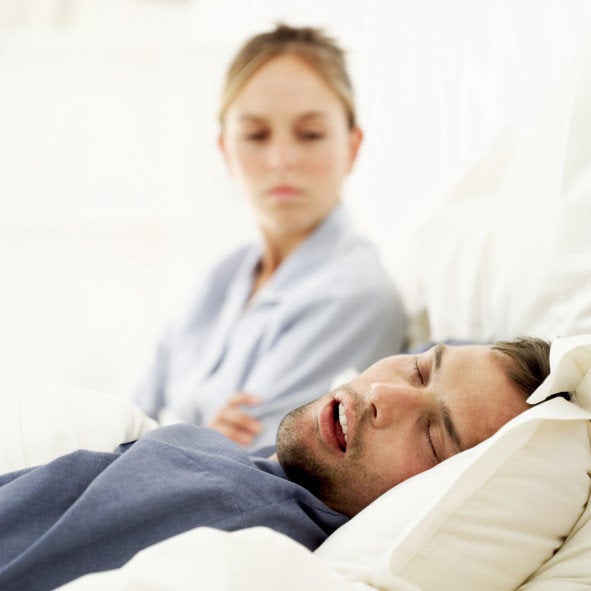
Sleep apnea is a disorder which is characterized by abnormal pauses in breathing (apneas) or abnormally low breathing (hypopneas) during sleep. These apneas can occur due to a lack of respiratory effort, due to a physical blockage to airflow, or a combination of both. Obstructive Sleep Apnea (OSA) is the most common type of apnea and occurs where there is a physical blockage of airflow.
Individuals with OSA are rarely aware of having difficulty breathing. In fact, the problem is often recognized by the person's bed partner or someone who sleeps in the same room. Patients suffering from OSA often feel fatigued during the day and report daytime sleepiness, which they often become used to. It is not unusual for a patient with sleep apnea to take naps during the day, fall asleep watching television or sitting in a car or fall asleep while talking to someone. Sleep apnea can also affect your work performance, vigilance, motivation and other behavioral or cognitive effects.
Snoring, on the other hand, is caused by vibration of respiratory structures due to obstructed air movement during breathing while sleeping. This is often caused by the uvula (the tissue that hangs down in the back of your throat), an elongated soft palate, a large tongue or obstructions in the nasal area.
Statistics on snoring suggest that as many as 50 percent of adults snore (1), while one in 15 Americans are affected by sleep apnea (2). While someone who snores may also suffer from sleep apnea, not all patient with sleep apnea snore. This means that even though you do not snore, it does not mean that you do not have sleep apnea. If you suffer from daytime sleepiness and fatigue, and don't feel refreshed in the morning after a good night's sleep, you should probably consider getting a sleep study. There are a few ways that you can get that done. The traditional method is to go to a sleep center, where you will sleep overnight while you are connected to a variety of devices that will monitor your body functions. These include brain activity, eye movements, muscle activity, heart rhythm and oxygen saturation. An alternative to this is to take a home testing device, which will also monitor certain of your body functions, but in the comfort of your own home and bed.
Treatment options for persons suffering from snoring and obstructive sleep apnea vary a great deal, from conservative treatment to invasive surgical treatment. Treatment for snoring includes positive airway pressure devices, dental appliances and surgeries that are customized to best address your individual needs. One such surgery is called the Pillar Procedure, which is a minimally invasive treatment where three to six woven polyester strips are inserted into the soft palate under local anesthesia. The soft palate eventually becomes more rigid, thereby reducing vibrations of the soft palate and minimizing snoring. If there are other factors contributing to snoring, then those will also need to be taken into consideration in order for the treatment to be more effective.
There are many treatment options for patients with obstructive sleep apnea. The first one is called Continuous Positive Airway Pressure device (CPAP), which is a machine that keeps the patient's airway open during sleep by delivering a continuous flow of pressurized air into the throat. Another option is an Oral Appliance Therapy (OAT), which is a custom-made mouthpiece that shifts the lower jaw forward, thereby opening the airway.
Other treatments include surgeries that aim at opening the airway at different levels where obstructions are commonly encountered. These surgeries are individualized to address all anatomical areas of obstructions for each patient and may include surgeries such as hyoid suspension, base of tongue advancement surgeries, pharyngeal surgeries and nasal surgeries. Maxillomandibular advancement (jaw surgery) is considered to be the most effective surgery for sleep apnea patients, and is often the treatment of choice for patients who suffer from severe OSA and/or who have failed all forms of conservative therapy. For more information on treatment of obstructive sleep apnea and snoring, feel free to visit our website.
If you suspect that you suffer from snoring or sleep apnea, the first step to take is to schedule an appointment with a sleep specialist who will perform a comprehensive examination and often recommend a sleep study. Once your doctor reviews your sleep study, your treatment plan can then be customized to address your condition and specific needs.
References:
(1) "New Vaccine Could Cure Snoring (statistics insert)". BBC News. 2001-09-19.
(2)Lee W, Nagubadi S, Kryger MH, Mokhlesi B (June 1, 2008). "Epidemiology of obstructive sleep apnea: a population-based perspective". Expert Rev Respir Med 2 (3): 349-64. doi:10.1586/17476348.2.3.349. PMC 2727690. PMID 19690624